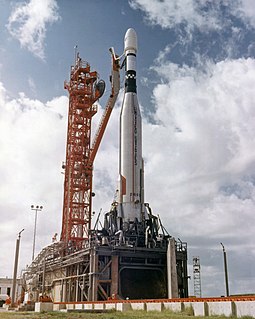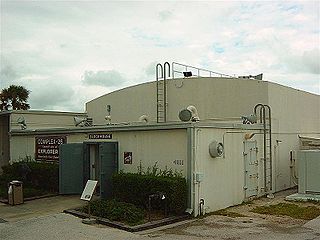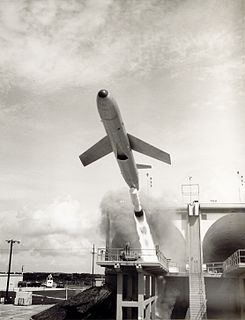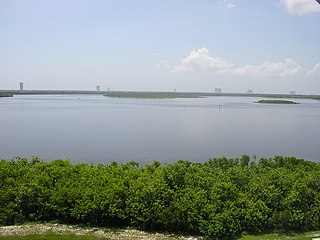 W
WCape Canaveral Space Force Station (CCSFS) is an installation of the United States Space Force's Space Launch Delta 45, located on Cape Canaveral in Brevard County, Florida.
 W
WCape Canaveral is a prominent cape in Brevard County, Florida, in the United States, near the center of the state's Atlantic coast. Officially Cape Kennedy from 1963 to 1973, it lies east of Merritt Island, separated from it by the Banana River. It is part of a region known as the Space Coast, and is the site of the Cape Canaveral Space Force Station. Since many U.S. spacecraft have been launched from both the station and the Kennedy Space Center on adjacent Merritt Island, the two are sometimes conflated with each other.
 W
WThe Air Force Space and Missile Museum is located at Launch Complex 26 at Cape Canaveral Space Force Station, Florida. It includes artifacts from the early American space program and includes an outdoor area displaying rockets, missiles, and space-related equipment chronicling the space and missile history of the US Space Force and other military branches.
 W
WLaunch Complex 1 (LC-1) is a deactivated launch site on the eastern tip of Cape Canaveral Space Force Station, Florida. It was constructed, with launch complexes 2, 3, and 4, in the early 1950s for the Snark missile program.
 W
WLaunch Complex 2 (LC-2) is a deactivated launch site on the eastern tip of Cape Canaveral, Florida at Cape Canaveral Space Force Station. It was constructed with launch complexes 1, 3, and 4, in the early 1950s, for the Snark missile program.
 W
WLaunch Complex 3 (LC-3) is a deactivated launch site southeast of SLC-36 on Cape Canaveral, Florida at Cape Canaveral Space Force Station. It was constructed, with launch complexes 1, 2, and 4, in the early 1950s for the Snark missile program.
 W
WCape Canaveral Launch Complex 5 (LC-5) was a launch site at Cape Canaveral Space Force Station, Florida used for various Redstone and Jupiter launches.
 W
WLaunch Complex 9 (LC-9) at Cape Canaveral Space Force Station is a launch pad on Cape Canaveral in Florida. It is north of Launch Complex 17. It is a small concrete structure consisting of an elevated launch pedestal and flame trench, centered on a small oval-shaped concrete pad.
 W
WLaunch Complex 11 (LC-11) at Cape Canaveral Space Force Station, Florida, is a launch complex used by Atlas missiles between 1958 and 1964. It is the southernmost of the launch pads known as Missile Row. When it was built, it, along with complexes 12, 13 and 14, featured a more robust design than many contemporary pads, due to the greater power of the Atlas compared to other rockets of the time. It was larger, and featured a concrete launch pedestal that was 6 metres (20 ft) tall and a reinforced blockhouse. The rockets were delivered to the launch pad by a ramp on the southwest side of the launch pedestal.
 W
WLaunch Complex 12 (LC-12) at Cape Canaveral Space Force Station, Florida was a launch pad used by Atlas rockets and missiles between 1958 and 1967. It was the second-most southern of the pads known as Missile Row, between LC-11 to the south and LC-13 to the north. Along with Complexes 11, 13 and 14, 12 featured a more robust design than many contemporary pads, due to the greater power of the Atlas compared to other rockets of the time. It was larger, and featured a concrete launch pedestal that was 6 metres (20 ft) tall and a reinforced blockhouse. The rockets were delivered to the launch pad by means of a ramp on the southwest side of the launch pedestal.
 W
WLaunch Complex 13 (LC-13) was a launch complex at Cape Canaveral Space Force Station, the third-most southerly of the original launch complexes known as Missile Row, lying between LC-12 and LC-14. In 2015, the LC-13 site was leased by SpaceX and was renovated for use as Landing Zone 1 and Landing Zone 2, the company's East Coast landing location for returning Falcon 9 and Falcon Heavy launch vehicle booster stages.
 W
WLaunch Complex 14 (LC-14) is a launch site at Cape Canaveral Space Force Station in Florida. LC-14 was used for various manned and unmanned Atlas launches, including the Friendship 7 flight aboard which John Glenn became the first American to orbit the Earth.
 W
WLaunch Complex 16 (LC-16) at Cape Canaveral Space Force Station, Florida is a launch complex built for use by LGM-25 Titan missiles, and later used for NASA operations before being transferred back to the US military and used for tests of MGM-31 Pershing missiles. Six Titan I missiles were launched from the complex between December 1959 and May 1960. These were followed by seven Titan II missiles, starting with the type's maiden flight on March 16, 1962. The last Titan II launch from LC-16 was conducted on May 29, 1963.
 W
WLaunch Complex 18 (LC-18) is a launch complex at the Cape Canaveral Space Force Station, Florida that was active during the late 1950s and early 1960s. It was used by Viking, Vanguard, Thor and Scout rockets. The complex consists of two launch pads, LC-18A, which was originally built by the US Navy for the Vanguard rocket, and LC-18B, which was originally by the US Air Force used for tests of the PGM-17 Thor missile.
 W
WLaunch Complex 19 (LC-19) is a deactivated launch site on Cape Canaveral Space Force Station, Florida used by NASA to launch all of the Gemini manned spaceflights. It was also used by unmanned Titan I and Titan II missiles.
 W
WLaunch Complex 26 (LC-26) is a deactivated launch site at Cape Canaveral Space Force Station, Florida. LC-26 consisted of two pads, A and B. Pad A was used for the Jupiter-C and Juno I rockets, and was the launch site for Explorer 1, the United States' first satellite, in 1958. Pad B was used for Juno II. Jupiter IRBMs were launched from both pads.
 W
WLaunch Complex 31 (LC-31) is a former launch complex at Cape Canaveral Space Force Station, Florida.
 W
WLaunch Complex 34 (LC-34) is a deactivated launch site on Cape Canaveral Space Force Station, Florida. LC-34 and its companion LC-37 to the north were used by NASA from 1961 through 1968 to launch Saturn I and IB rockets as part of the Apollo program. It was the site of the Apollo 1 fire, which claimed the lives of astronauts Gus Grissom, Ed White, and Roger Chaffee on January 27, 1967. The first crewed Apollo launch — Apollo 7 on October 11, 1968 — was the last time LC-34 was used.
 W
WLaunch Complex 36 (LC-36)—formerly known as Space Launch Complex 36 (SLC-36) from 1997 to 2010—is a launch complex at Cape Canaveral Space Force Station in Brevard County, Florida. It was used for Atlas launches by NASA and the U.S. Air Force from 1962 until 2005.
 W
WLaunch Complex 45 (LC-45) is a former launch complex on Cape Canaveral Space Force Station created to launch the Roland missile. However, it was never used prior to its destruction, and Launch Complex 46 is now in its location.
 W
WCape Canaveral Launch Complex 47 is a launch pad for sounding rockets located at the north end of Cape Canaveral Space Force Station, Florida. It is the smallest launch complex used in the air force station. The complex features a small blockhouse a few yards from the pad, containing vehicle-specific hardware. Between 1984 and 2008, 531 sounding rockets were launched from pad 47. All weather rocket operations were relocated here from Launch Complex 43 in 1984 in order to make room for the construction of Launch Complex 46.
 W
WThe Cape Canaveral Light is a historic lighthouse on the east coast of the U.S. state of Florida. The light was established in 1848 to warn ships of the dangerous shoals that lie off its coast. It is located inside the Cape Canaveral Space Force Station and managed by the Space Launch Delta 45 of the U.S. Space Force with the assistance of the Cape Canaveral Lighthouse Foundation. It is the only fully operational lighthouse that is owned by the United States Space Force.
 W
WSpace Launch Complex 17 (SLC-17), previously designated Launch Complex 17 (LC-17), was a launch site at Cape Canaveral Space Force Station, Florida used for Thor and Delta rocket launches between 1958 and 2011.
 W
WSpace Launch Complex 37 (SLC-37), previously Launch Complex 37 (LC-37), is a launch complex on Cape Canaveral Space Force Station, Florida. Construction began in 1959 and the site was accepted by NASA to support the Saturn I program in 1963. The complex consists of two launch pads. LC-37A has never been used, but LC-37B launched uncrewed Saturn I flights and was modified and launched Saturn IB flights, including the first (uncrewed) test of the Apollo Lunar Module in space. It was deactivated in 1972. In 2001 it was modified as the launch site for Delta IV, a launch system operated by United Launch Alliance.
 W
WSpace Launch Complex 40 (SLC-40), previously Launch Complex 40 (LC-40) is a launch pad for rockets located at the north end of Cape Canaveral Space Force Station, Florida.
 W
WSpace Launch Complex 41 (SLC-41), previously Launch Complex 41 (LC-41), is an active launch site at Cape Canaveral Space Force Station. As of 2020, the site is used by United Launch Alliance (ULA) for Atlas V launches. Previously, it had been used by the USAF for Titan III and Titan IV launches.
 W
WThe Space Launch Complex 46 (SLC-46), previously Launch Complex 46 (LC-46), is a launch complex at Cape Canaveral Space Force Station operated under license by Space Florida for Athena rocket launches.
 W
WThe Eastern Range (ER) is an American rocket range (Spaceport) that supports missile and rocket launches from the two major launch heads located at Cape Canaveral Space Force Station and the Kennedy Space Center (KSC), Florida. The range has also supported Ariane launches from the Guiana Space Centre as well as launches from the Wallops Flight Facility and other lead ranges. The range also uses instrumentation operated by NASA at Wallops and KSC.
 W
W W
WLanding Zone 1 and Landing Zone 2, also known as LZ-1 and LZ-2 respectively, are landing facilities on Cape Canaveral Space Force Station for recovering components of SpaceX's VTVL reusable launch vehicles. LZ-1 and LZ-2 were built on land leased in February 2015, on the site of the former Cape Canaveral Launch Complex 13. SpaceX built Landing Zone 2 at the facility to have a second landing pad, allowing two Falcon Heavy boosters to land simultaneously.
 W
WLaunch Complex 21 (LC-21) at Cape Canaveral Space Force Station, Florida is a launch complex that was used for horizontal launches of cruise missiles between 1958 and 1963. It initially consisted of a single launch rail, from which XSM-73 Bull Goose missiles were tested. Between 1959 and 1960, the complex was rebuilt for the MGM-13 Mace, with a second rail added, and a large concrete structure erected around the launch rails, earning the pad the nickname of "the hardsite".
 W
WCape Canaveral and adjacent Merritt Island on Florida's Atlantic coast are home to two American spaceports, one civilian and one military, servicing several active launch sites.
 W
WMissile Row was a nickname given in the 1960s to the United States Space Force and NASA launch complexes at Cape Canaveral Space Force Station (CCSFS). Operated by the 45th Space Wing since 1949, it was the site of all pre-Apollo 8 manned launches, as well as many other early Department of Defense (DoD) and NASA launches. For the DoD, it plays a secondary role to Vandenberg AFB in California, but is the launch site for many NASA unmanned space probes, as those spacecraft are typically launched on United States Space Force launchers. Active launch vehicles are in bold.
 W
WThe Spacecraft Assembly and Checkout Building was built in 1959 for a Department of Defense missile program. The facility was acquired in 1960 by NASA and modified for unmanned missions.